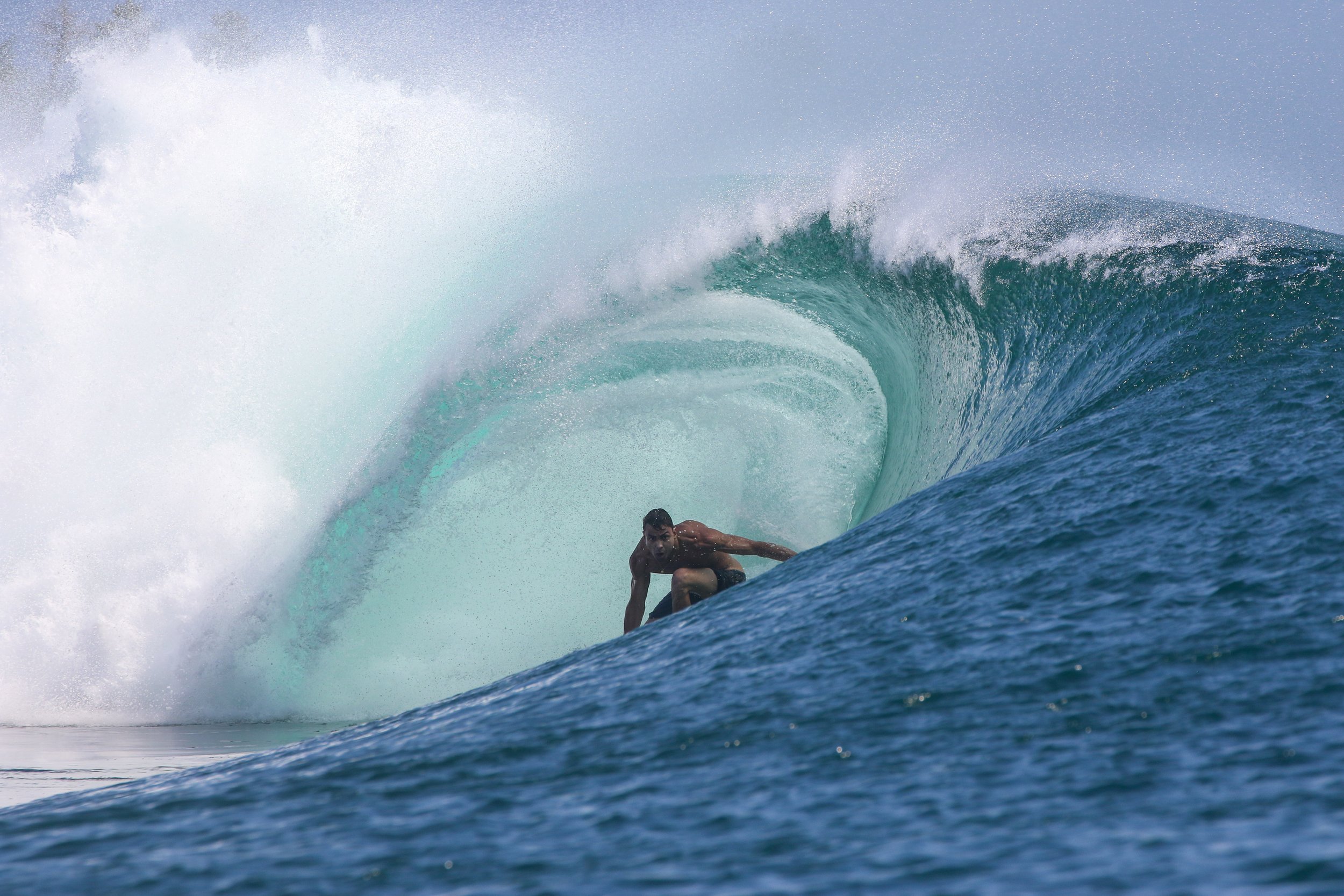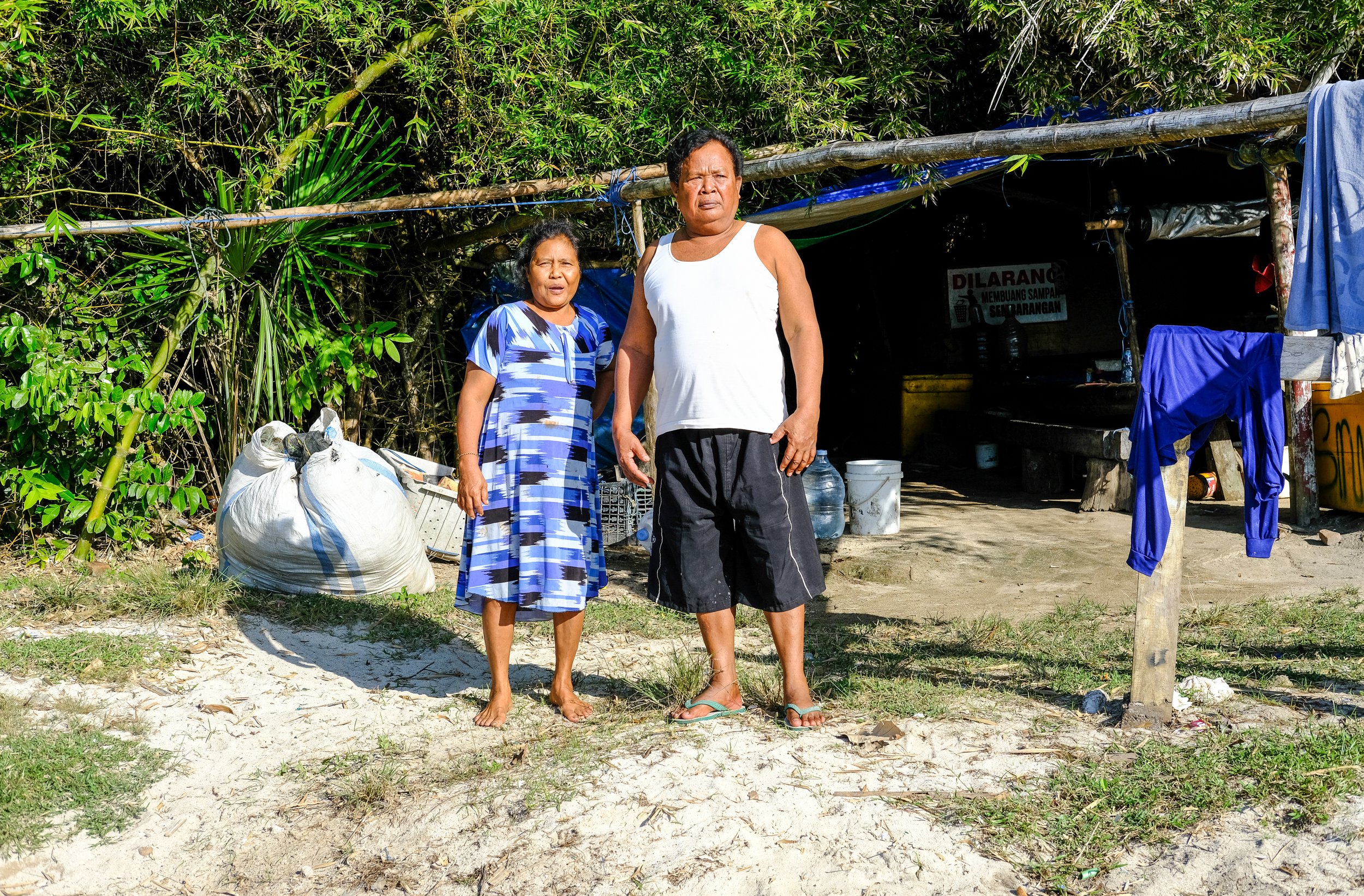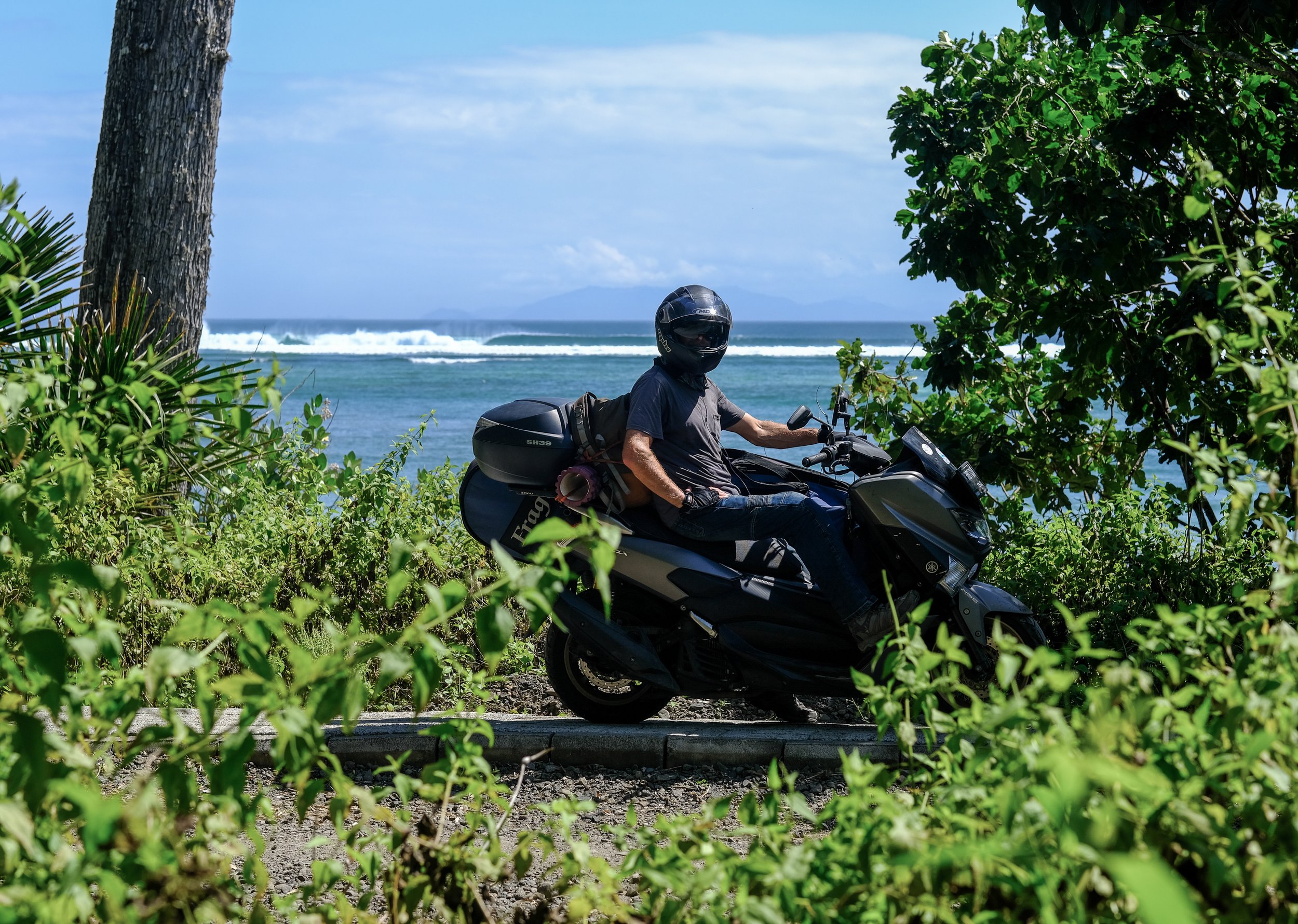The front wheel of my motorbike wobbles as I ride down Jalan Sunset Road. I wonder if it’s the weight of the surfboards on the side or if the wheel is actually loose and this thing is just a bloody death trap. Those dicky front drum brakes, ignition barrel rattling loose, the sputtering single-cylinder 230cc motor, all of it slapped together in some Indonesian backyard garage.
Riding in Indonesia is similar to surfing in a way, and for the next six months I’m here for both of those things, exploring the archipelago by motorbike in search of empty, perfect waves. As I ride I find a rhythm, looking for lines through the traffic and learning to read the natural order to this chaos.
Across the Java Strait and into Banyuwangi, the city becomes village, and then rice paddies, and then jungle. I roar down the straight and narrow bitumen road, screaming with a joy as the late afternoon streams through the trees. This is the Alas Purwo National Park. It is an important place in Javanese myth; Alas Purwo, ancient forest, where the Javanese believe that land first emerged from the Indian Ocean any many believe it still to be haunted.
It is also home to an important place in surfing myth. G-Land, a kind of Indonesian surfing Mecca. That fabled left-hander reeling down two-kilometres reef on the edge of the jungle. Tubes to transport you through space and time and linger in your mind forever. Every surfer has heard of the place, some know it intimately.
Now, I’m seeing it for the first time.
I find lodgings in one of the four camps on the edge of the jungle overlooking the wave. At $100USD per night, it is the cheapest.
Laying eyes on the wave for the first time, and it is nowhere near as perfect as I imagined it. It sputters down the reef, impossibly fast through some parts, big crumbling wedges appearing in the wave face ahead, other parts fizzling out into deep water.
As if the wave itself wasn’t hard enough to figure out, there is a crowd of 100-plus surfers. Rapacious Aussies, Californians, Brazilians, Europeans, all competing to try and convert their bucks into tube time. Can you put a monetary value on the wave your life? Here, it’s gotta be worth a good few grand.
Beyond the pack, an older surfer sits way outside on an orange 7’8 Tokoro gun. 74-year-old Larry McGraw is a dentist from Oahu and has been here every season since 1987, including two seasons during COVID, where he was for a time the only surfer in the camp. He sits and waits for his waves. He knows just how critical patience and luck and wave selection are out here, and in a four-hour session he rides only five waves.
“It’s a wave you really have to get to understand. There are so many variables. Ten feet of tide means you’re surfing an entirely different part of the reef on different tides, and the wave does different things on different swell directions. It’s so tricky, and you can really see the surfers who have put in the time and developed a relationship with the wave,” he says.
In all of his stints Larry has seen many of the top professionals surfing here, but he credits West Australian Jeffrey ‘Camel’ Goulden as the best he has ever seen.
“He would get two completely different snapped boards and Frankenstein them together, then offset the fins. He would paddle it out on the biggest, gnarliest days, where it was washing through and the risk far outweighed the reward, and still find the nugs.”
“He’s gotta be one of the best soul tuberiders I have ever seen.”
The day after the forecast swell at G-Land there is a mass exodus from the camp. The line-up is uncrowded, the waves still four-to-six feet and glistening in the afternoon sun. I start to connect with the wave, getting a better read on the incoming swells, and riding one long deep tube on the end section that makes the expense and the long ride across and the crowds and the hassle all worthwhile.
When the swell disappears I wander along the edge of the reef and into the bay. On the edge of the jungle is a hut made from bamboo poles and old canoe paddles lashed together, the roof a double layer of tarpaulin. This is the fishing camp of 73-year-old Pak Samon. He was one of the first from Grajagan to begin venturing here in search of better fishing grounds.
Like many Javanese, Pak Samon is highly superstitious, and he claims this area to be haunted. The wider Banyuwangi region is also renowned as a powerful centre of witchcraft in Java; in 1998, over 200 people suspected of being duken santat, or black magic practitioners were massacred in a series of revenge killings. While many of the more extreme beliefs have been pushed underground, to local people this is still a supernatural area.
“There are ghosts. Here in Alas Purwo, almost everybody believes it. Sometimes you see them as a normal person, sometimes you see them as a shadow a little bit bigger than a human. It is the belief of the Javanese people. We believe that there are spirits in the jungle, and people have held those beliefs for a long time,” says Pak Samon.
“Everyone has different views, but in my view, the ghost comes from inside you. From inside your heart. I have seen the shadows, heard the voices.”
Back at the camp, I cross paths with Brendan Lyss, a 51-year-old former undercover police officer who has been travelling around Indonesia the past six years. As an undercover cop Brendan was forced to live a lie, and eventually that lie became the truth, spiralling into drug addiction and dangerous behaviour. Brendan is here because travelling and surfing is the solution that medication and psychologists could not offer him.
“I feel I’ve cured myself through travel. I feel amazing. I feel really privileged to be able to do this, and now I like my own company. I don’t have any demons I’m battling with. It’s just so liberating. And then seeing people who don’t have much and they’re just so welcoming and so happy and so friendly, pleased to meet you, to share a coffee with you.
“Being exposed to the elements, the power of the waves and the weather and working with those things, it’s a very healing thing. It was the best therapy. It kept me so busy, so focused. It did for me what the psychologist and the psychiatrists and rehab and stuff couldn’t. That was my rehab, I guess.”
“I feel so free, buzzing around on my motorbike with my surfboards, not knowing where I’m going to stop the next day.”
See that little white thing bobbing out there? Is that a white cap? Surely, but no, it’s a little fishing canoe! What the hell is it doing here, bobbing around 20 miles out to sea in the Alas Strait, one of the fastest moving bodies of water in the world? Eight knots of current, water moving so fast it’ll stand up and make waves against opposing wind or swell.
Pak Anuddin points to the boat.
“He knows what he’s doing. He’ll work with it and use it to get home,” he says.
Pak Anuddin knows the importance of working with the ocean. You can’t beat it, only join it, he’s come to understand in the last 11 years travelling the world working a cargo ship. Right now, he’s on his way back to Bima, Sumbawa, to spend two months off with his family before heading back out to sea for the next ten months.
Like the rest of the ferry passengers, he’s crossing this strait from Bali to Lombok for work or family, these bringing the same sense of fulfilment and purpose to the Indonesian people that I’m here seeking in surfing. All of us, on a pilgrimage of sorts. Ardi, heading back to Sumbawa after selling 20 cattle in Jakarta. Rizki and Fendi, a married couple travelling from West Java to the wife’s village in Sumbawa for the first time in five years.
Me, on my way to one of the best waves in the world.
Desert Point.
Compared to the mysticism and luxury of G-Land, Desert Point is a surfing ghetto. Digs are in raised huts, the roofs and walls thatched crudely with alang-alang. Some leak when it rains. 200k rupiah a night here buy you a bed on a concrete pad, a toilet you have to flush with bucket and scoop, and a trickling little one-inch PVC pipe shower. There is no fan and only one naked, hard-bright lightbulb; everything runs off the diesel generator chugging away beside the cow paddock down back.
It’s a small price to pay when you see the quality of the wave. Glistening six-to-eight feet tubes reeling the entire 300m length of the reef, hypnotising everyone in the beachfront warungs. A Mexican wave of grunts and hollers follow each set wave down the point, ending in riotous cheering at the mostly Brazilian occupied warung in front of The Grower end-section.
As the first proper swell of the season fills in, The Grower builds to eight-to-ten feet plus. A handful of crew are paddling it, including Australian slab-hunter Kipp Caddy, who’s come here with eyes specifically on this section.
“It’s really heavy,” he says.
“It’s kinda deep down there and there’s so much water in the wave that you don’t have to worry too much about hitting the reef. It’s more drowning material. Kinda like Puerto, where it seems to kind of keep you in the impact zone. It’s a psycho wave. Good training for Pipe.”
Kipp rides a handful of closeouts and one long, deep tube on his backhand, before turning his attention back up the point.
Up there, the vibe in the lineup is intense; the crowd on par with Pipeline and Snapper Rocks. 100 surfers jostling for position in the small take-off area, sometimes seven or eight people taking off on the one wave. To snag a set wave requires you to adopt an animalistic sort of approach. Rules of the jungle. Every other surfer is an enemy.
Sometimes the politics of the lineup spill onto land. I watch a near collision between a Hawaiian and a Brazilian surfer. After an apology from the Hawaiian, all seems to be resolved, but later, the Brazilian and a group of four friends arrive at the Hawaiians camp and confront him at his table. There is a tense stand-off. A local intervenes, defusing the Brazilian group.
Each day passes in a blur of tubes and mie-goreng and extra-joss and Sampoerna cigarettes and coconuts. Time seems to take on a different dimension in Indonesia. Sebentar lagi, one more moment, can mean months. Kemarin, yesterday, years in the past, besok, tomorrow, years ahead. Here, at Desert Point, time transcends that dimension again. 20-second tubes that distort the reality of time and space, everything slowing to a standstill, minutes, hours, years, lifetimes slipping by.
For one man here at Desert Point, 15 years have passed by in these tubes. John Kelly first came here in 2008, and he’s been here ever since, raising his ten-year-old son, Samudera Hindia (meaning Indian Ocean in Indonesian) in spinning tropical tubes and swaying coconut palms.
“Even before I first came here I felt connected to the place. Just the feel of the land and the slow life. Growing food, living by the seasons and the tides. And sure, there’s the wave too. That’s obviously a big drawcard.”
As a Westerner living here permanently, John is something of an outsider in the community. He lives on the outskirts of the village and surf camps in a traditional Sasak style house, and says while there are many smiling faces and genuine, kind-hearted people here, there is also an underlying sentiment of distrust and dislike of Westerners among the local people.
“It is partly religious, and because of the way they see us. A lot of people here just see all Westerners as lacking respect for their religious beliefs. You’re kind of just a source of income. It makes it kind of hard living here full-time,” he says.
“You just gotta go all Jimi Hendrix, eyes to the sky. It wears you down sometimes, but you just gotta accept it. It’s part of the cost of living here.”
Each day, the swell rises and fades with the vagaries of tide. On the slack part of the tides it disappears almost completely, before climbing back up to overhead, double overhead, triple overhead within 40 minutes, sending a flurry of surfers scrambling into the lineup. Out behind the break, small wooden perahu fishing boats follow it in, sails hoisted and trawling out behind the break. Both groups, scouring the ocean for the fruits that arrive and disappear with the tide.








